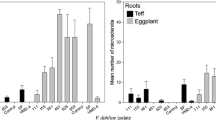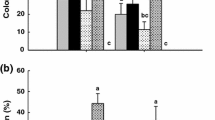Abstract
Verticillium dahliae is a strong soil-borne pathogen that causes early dying of potato plants. Pathogen population dynamics were studied during disease development following combined inoculations of potato withV. dahliae and various otherVerticillium species. In greenhouse and field studies, threeVerticillium species were examined:V dahliae, V. albo-atrum ‘group 2’ andV tricorpus. Potato plants were inoculated with two out of the three species in various combinations of an aggressive (V. dahliae) and weak (V albo-atrum ‘group 2’ orV tricorpus) pathogen either on the same date or with a weak species followed by an aggressive species four days later. Plant and soil samples were collected and relative population levels (RPLs) of each pathogen were determined using polymerase chain reaction (PCR) techniques. In combinations where pathogens were inoculated at the same time, RPLs of the weaker species did not exceed those of the aggressive species. In combinations where the weaker species were inoculated first, followed byV. dahliae four days later, the two weaker species were still not able to exceed RPLs ofV. dahliae. visual wilt symptoms, however, were significantly lower than co-inoculations at the same time and the single inoculation studies. Implications of these findings on epidemiological aspects of these hostpathogen interactions are discussed.
Resumen
Verticillium dahliae es un poderoso patógeno habitante del suelo que causa muerte prematura de plantas de papa. La dinámica poblacional del patógeno ha sido estudiada durante el desarrollo de la enfermedad después de inoculaciones combinadas de papa conV. dahliae y varias otras especies deVerticillium. En estudios de invernadero y campo, se examinaron tres especies deVerticillium: V. dahliae, V. albo-atrum ‘grupo 2’yV. tricorpus. Plantas de papa fueron inoculadas con dos de las tres especies en diferentes combinaciones de un patógeno agresivo (V dahliae) y uno debil (V albo-atrum ‘grupo 2’ oV. tricorpus) en la misma fecha o con una especie débil seguida de una agresiva cuatro días después. Se colectaron muestras de planta y de suelo y se determinaron los niveles de poblacion relativa (RPLs) utilizando técnicas de reacción en cadena de la polimerasa (PCR). En las combinaciones donde los patógenos fueron inoculados al mismo tiempo, los RPLs de las especies débiles no excedieron a aquellas de las especies agresivas. En combinaciones en las que las especies débiles fueron inoculadas primero, seguidas deV. dahliae cuatro dias después, las especies más débiles no fueron capaces de exceder los RPLs deV. dahliae. Los síntomas visuales, sin embargo fueron significativamente menores que las co-inoculaciones simples de un mismo tiempo. Se discuten las implicancias de estos hallazgos sobre aspectos epidemiológicos de las interacciones huésped-patógeno.
Similar content being viewed by others
Abbreviations
- VD:
-
Verticillium dahliae
- VT:
-
Verticillium tricorpus
- VA2:
-
Verticillium albo-atrum
Literature Cited
Davis JR. 1985. Approaches to control of potato early dying caused byVerticillium dahliae. Am Potato J 62: 177–185.
Davis JR, DO Everson, LH Sorensen and AT Schneider. 2000. Association ofVerticillium tricorpus with soil suppressiveness of verticillium wilt of potato.In: EC Tjamos, RC Rowe, JB Heale and DR Fravel (eds), Advances in VerticiUium Research and Disease Management. APS Press, St. Paul, MN, USA. pp 347–351.
Davis JR, OC Huisman, DT Westermann, SL Hafez, DO Everson, LH Sorensen and AT Schneider. 1996. Effects of green manures on verticillium wilt of potato. Phytopathology 86: 444–453.
Dobinson KF. 1995. Genetic transformation of the vascular wilt fungusVerticillium dahliae. Can J Bot 73: 710–715.
Easton GD, ME Nagle and MD Seymour. 1992. Potato production and incidence ofVerticillium dahliae following rotation to nonhost crops and soil fumigation in the state of Washington. Am Potato J 69: 489–502.
Heinz RA and HW Piatt. 2000. A competitive PCR-based assay to quantifyVerticillium tricorpus propagules in soil. Can J Plant Pathol 22: 122–130.
Isaac I.1953. A further comparative study of pathogenic isolates of verticillium:V nubilum Pethybr. andV. tricorpus sp. nov. Trans Br Mycol Soc 36: 180–195.
Jeger MJ, GA Hide, PHJF Van Den Boogert, AJ Termorshuizen and P Van Baarlen. Pathology and control of soil-borne fungal pathogens of potato. Potato Res 39: 437-469.
Keinath AP, DR Fravel and GC Papavizas. 1991. Potential ofGliocladium roseum for biological control ofVerticillium dahliae. Phytopathology 81: 644–648.
Lucas JA. 1998. Biological control of plant disease.In: Plant Pathology and Plant Pathogens, Ed 3. Blackwell Science Ltd., Maiden, MA, USA. pp 233–248.
Mahuku GS and HW Platt. 2002. Molecular evidence thatVerticillium albo-atrum Grp 2 isolates are distinct fromV. albo-atrum Grp 1 andV. tricorpus. Mol Plant Pathol 3(2): 71–79.
Mahuku GS, HW Piatt and P Maxwell. 1999. Comparison of polymerase chain reaction based methods with plating on media to detect and identify verticillium wilt pathogens of potato. Can J Plant Pathol 21: 125–131.
Platt HW. 1986. Varietal response and crop loss due to Verticillium wilt of potato caused byV albo-atrum. Phytoprotection 67: 123–127.
Powelson ML and RC Rowe. 1993. Biology and management of early dying of potatoes. Ann Rev Phytopathol 31: 111–126.
Robb J, R Moukhamedov, X Hu, HW Piatt and RN Nazar. 1993. Putative subgroups ofVerticillium albo-atrum distinguishable by PCRbased assays. Physiol and Mol Plant Pathol 43: 423–436.
Robinson N, HW Platt and L Hale. Interactions of variousVerticillium species in combination withV albo-atrum on verticillium wilt disease development in potato. Amer J Potato Res 84: 133-141.
Schnathorst WC. 1981. Life cycle and epidemiology ofVerticillium. In: M Mace, A Bell and C Beckman (eds), Fungal Wilt Diseases of Plants. Academic Press Inc., New York, NY. pp 81–111.
Tjamos EC and DR Fravel. 1995. Detrimental effects of sublethal heating andTalaromyces Flauus on microsclerotia ofVerticillium dahliae. Phytopathology 85: 388–392.
Author information
Authors and Affiliations
Corresponding author
Additional information
RPL, relative population level Contribution: AAFC-CLRC # 1057
Rights and permissions
About this article
Cite this article
Robinson, N., Piatt, H.W. & Hale, L.R. Verticillium dahliae interactions with V. albo-atrum and V. tricorpus and their effects on verticillium wilt disease development in potato. Amer J of Potato Res 84, 229–235 (2007). https://doi.org/10.1007/BF02986272
Accepted:
Issue Date:
DOI: https://doi.org/10.1007/BF02986272




